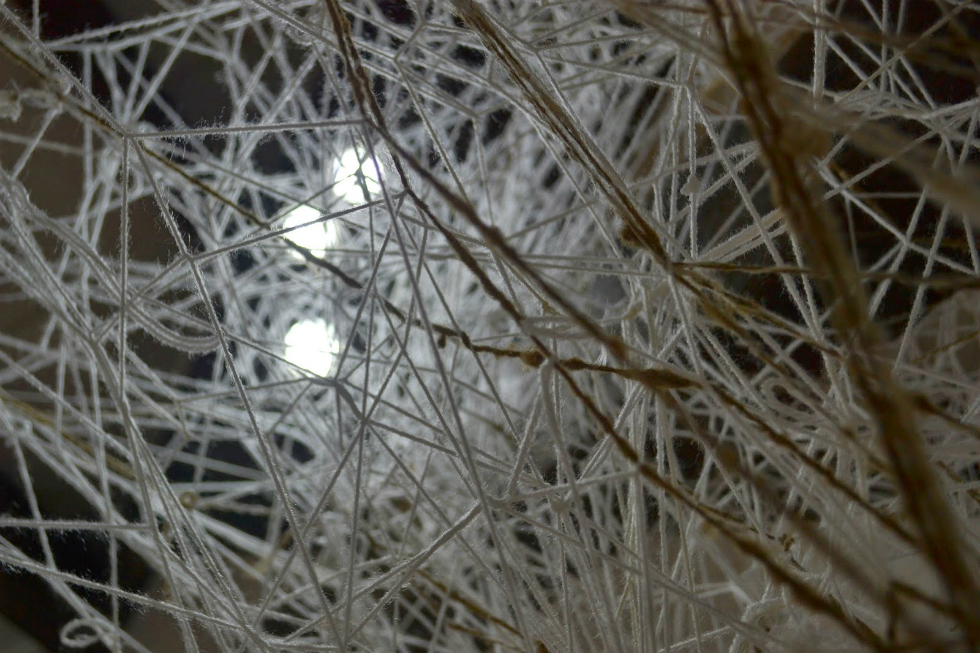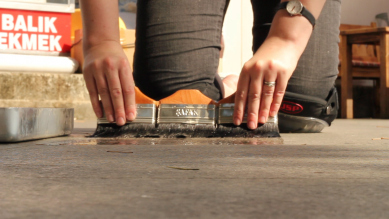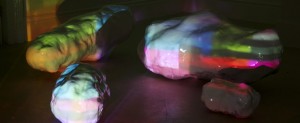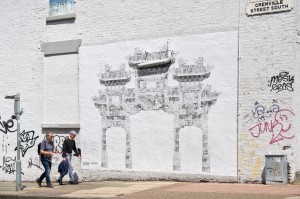Making Residencies Radical: Residual Projects

As part one of Residual Projects mini-residency programme comes to a close this weekend, Eleanor Clayton considers its format: promising an alternative for artists who are often torn between commitments at home and work with pursuing arts opportunities…
Residual Projects is a slippery beast. Not only an exhibition, it is also a series of short residencies, a presentation of process-based practice, and a questioning of the blank curatorial space outlined in Brian O’Doherty’s famous Inside The White Cube (2000).
Between its opening in December last year and until the end of this weekend, seven artists from across the UK will each have had consecutive ‘miniature residencies’ held in the Bradford-based South Square Centre (then moving on to Manchester in Spring 2015 for part two). The work produced during these residencies have, over time, created a constantly shifting group show, but one in which each subsequent artist is forced to engage with the work of their fellow exhibitors as it collectively forms the environment in which new work is created.
Residual Projects’ curator Charlie Booth has likened this experience to the nature of working at South Square Centre itself – the visual arts and resource centre in which the projects are held – due to the remnants of previous exhibitions scattered throughout the exhibition spaces which additionally retain features from its original use as a stonemason’s cottage.
One of Booth’s key lines of enquiry is the nature of residencies. Traditional residencies are so-called because they often offer a residence, a place for the artists to live. The Residual Projects artists do not reside at South Square, but are present, working on their practice in the gallery space for roughly one week. In this way, the mini-residencies offer a finite time and a particular space to develop practice that is in-line with more traditional residencies, but posit an alternative to those which require the artist to re-locate for months at a time.
Booth explains the motivation for this experimental form of residency, noting that “for many emerging artists, residencies of the traditional format are simply not an option, as they have part-time work that they cannot just leave for long periods of time. Additionally, for artists who are also primary care-givers to their children, living away from home is also not possible.”
These mini-residencies, then, are re-thinking the format to make these opportunities more accessible to those without independent means, or who have childcare responsibilities (often women). Surely this can only be a good thing?

There is one obvious draw-back. A significant difference with this new format of residency lies in the public accessibility of the artist as they work. Although a majority of residencies incorporate a public facing element, a show or display of work made during the period, in Residual Projects the whole residency is on display. By holding the residencies during gallery opening hours, allowing flexibility to accommodate family commitments or other work, the artists will be on display while they ‘explore their own artistic interests’, as the press release states.
In some ways, this is the opposite of a traditional residency where the artist has private time to experiment and contemplate, away from the constant drive for production. Surely this would be off-putting to many artists, as the presence of a public, however benign, casts a performative shadow over all actions.
Speaking to participating artist Claire Weetman, usually based in St Helens, it is clear that this 9-5 short-term residency model is ideal in these circumstances (heavily pregnant at the time of the interview) , although Weetman does note the benefit of previous, more traditional residencies as being “time away from all those mundane household daily grind commitments”.
As the first residency artist, Weetman’s project at South Square started with research into the living spaces that once occupied the gallery site, connecting to an ongoing interest in housing and tracing social histories. In doing so, Weetman obtained records of how many adults lived in the site’s cottage at various intervals from 1881 onwards, then determined how many square metres each person would have as their living space.
At the opening night, there was a labyrinth of tape measures being manoeuvred by enthusiastic volunteers. It took a while to work out what was going on — handed a tape measure and told to find a square missing a side with little other information. With the square dutifully completed in the neighbouring gallery, things became clearer as Weetman called out, like someone directing line dancers: “Now we’re going to do 1911, so you’ll need five orange and three yellow tape measures”.
Over the next few hours, the galleries were filled with square over square of the tape measures, delineating the space an inhabitant would have had at multiple dates. During the rest of her residency Weetman fixed these squares on the floor with ruler-marked sticky tape, showing documentation of the opening night’s interactive performance alongside audio recordings of previous inhabitants describing living in the cottage in 1941.
Asked about the performative nature of the residency, Weetman is sanguine. “Active live intervention”, as she puts it, is part of her practice and depends on participation as was evident during the opening. The other residency artists did express concerns about “working in the open gallery” and the possibility of being “perceived as ‘performing’”.
However, Booth has witnessed overall a positive residency experience. “This generally had a mixed response with the different artists during their residencies — for some, the interruption of people visiting the gallery was at first awkward, as they felt uncomfortable with having to engage with the audience explaining their work in such an environment.
“But for others, for example Leah Hislop, whose previous work is often created openly within the public realm, enjoyed being able to demonstrate the weaving processes employed within her installation. She found conversations with visitors from the local area interesting and was able to share knowledge on the textile industry.”

The focus on process-led work aims to encourage repeat visits as people speak to the artists and want to come back to find out what happens next. Despite trepidation, the same artists who expressed concerns also felt that it would be interesting to see how these conversations, or having their work observed in process, affected their practices.
There are other concerns relating to the format, which could be best described as involving group show etiquette, normally the curator’s problem rather than the artist’s. When I remarked upon Weetman’s effective but slight intervention she noted being “very aware of being the first’” not wanting to “completely take over the space.” By the end of the evening, the gallery felt full, but Weetman’s plans to replace the measuring tapes with adhesive strips eventually led to accommodate plenty of other work during the rest of the residencies.
“Each artist was generally very careful and respectful of the work already in the space,” reflects Booth, “that it did not obstruct or limit the subsequent artists in their choice of placement or production. Visitors commented on the links between all of the exhibits… I think that shows in the final layout of the exhibition.
“Most artists took direct inspiration from the products or remnants of the previous artists work. Bradshaw’s drawings were based upon objects found in the space, left primarily by Ian Jackson and Claire Weetman. Rebecca Long and Cameron Muir working as a partnership during their residency plotted the location of their sculpture, entitled Joseph, based upon the measuring tape lines criss-crossing the floor from Weetman’s residency. In turn, Tom McGinn‘s projection work incorporates Long and Muir’s sculpture as a base in which to project upon. This new external feature to their work is something which interests and excites the couple, to see how other artists interpret their work and are inspired by it.”
How the exhibition will grow in Manchester is a mystery, but it will certainly be an interesting process. The closing event in Bradford tonight will be a key moment at which the artists will reflect on this new format of residency, interrogating all its successes and failures. As with any experiment, all we can do is watch this space…
Eleanor Clayton is a writer and curator based in Manchester
The Residual Projects closing party will be at South Square Centre TONIGHT 7-9pm, and exhibition continues until Sunday 25 January 2015 (12-3pm). Part two of the project will continue in Manchester City Centre in Spring 2015 — see the Residual Projects blog for updates
Residency artists are: Claire Weetman – Ian Jackson – Alice Bradshaw – Rebecca Long & Cameron Muir – Leah Hislop – Tom McGinn
I Sought Solitude Group Show, curated by Abi Mitchell, opens Friday 6 February 7-9pm, and continues until 22 February 2015
South Square, Thornton, Bradford, BD13 3LD
Email: info@southsquarecentre.co.uk // Telephone: +44 (0)1274 834 747





